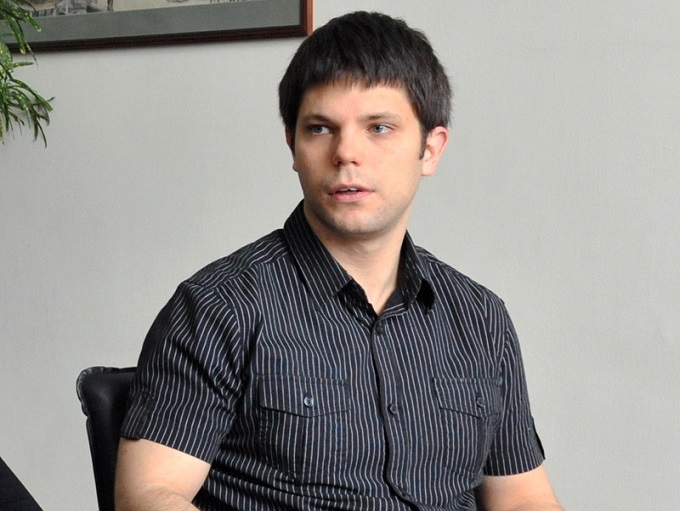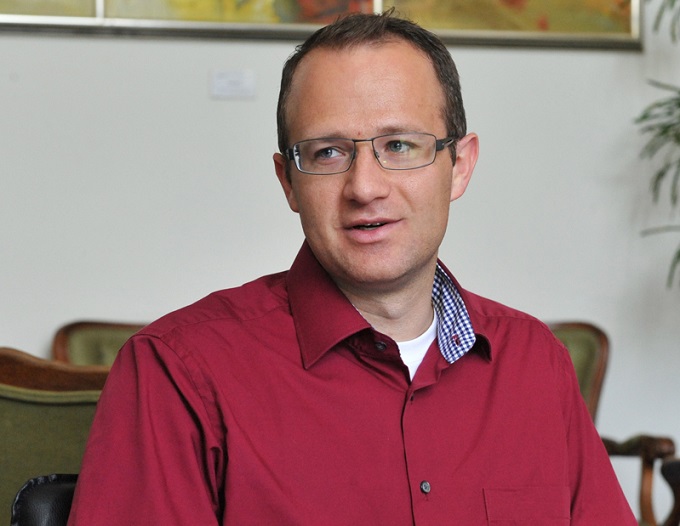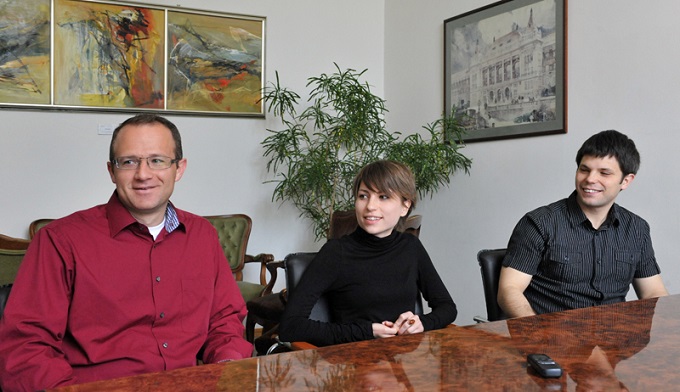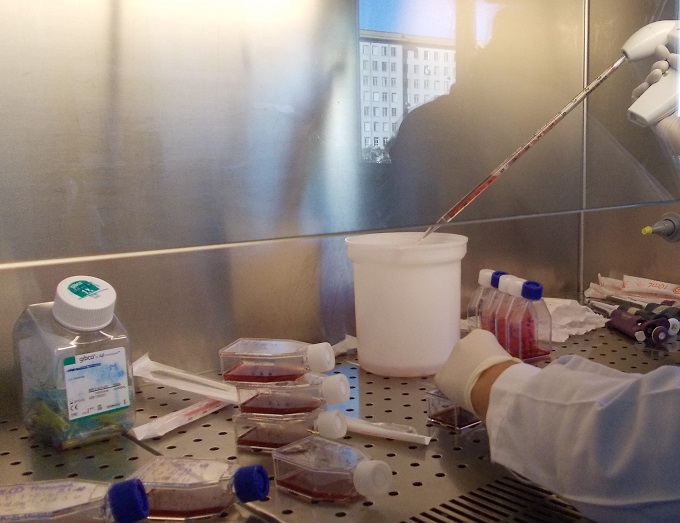News feed
New Alternative in Malaria Diagnosis
2014. 08. 27.Researchers of the Institute of Physics of BME Faculty of Natural Sciences published a new, inexpensive method for the detection of malaria parasites in early stage of the disease, in the PlosONE journal.
Malaria is a widespread disease in tropical and subtropical regions of Africa, Asia and the Americas, infecting around 300-500 million people a year and killing several millions. In Europe malaria occurs among the continually growing number of tourists and people travelling to tropical countries for employment; at the same time the disease may reoccur in Hungary due to ongoing climate changes.
Malaria is caused by parasitic protozoans of the genus Plasmodium; the disease is transmitted by a bite from an infected female Anopheles mosquito. The key element of treatment of malaria is early and proper diagnostics because some medications may develop resistance in the parasites causing the disease.
| The diagnostic methods currently in practice, like microscopic observation of infected red blood cells in blood smears require highly qualified specialists and success greatly depends on the examination circumstances and the qualification level of the microscopist. Other methods, like RTD (Rapid Diagnostic Test) has lower level of detection limits and the reagents need cooling. The PCR (Polymerase Chain Reaction) test requires expensive equipment and reagents, highly trained laboratory personnel; most of which are rarely present in real life practice. |
Malaria parasites produce hemozoin, a micro-crystalline heme compound in the blood as they detoxify free heme derived from hemoglobin digestion. The quantity of hemozoin grows as disease develops in the body therefore the existence of such malaria pigments is an obvious sign of the infection. The idea that the unique magnetic properties of malaria pigment (hemozoin) can be identified by optical diagnosis was proposed by a British research team in 2008. On the basis of their findings researchers of BME decided to examine the possibilities to develop alternative diagnostic equipment. (Editor’s note: the first results of the project were published on bme.hu earlier.) The technique offers a rapid and inexpensive testing method which does not rely on the skills of the person performing the examination. In countries – mainly in the third world - where there is serious shortage of well-trained professionals and health care infrastructure is rather poor such equipment can be a huge achievement in the fight against the disease. “Our long-term target is to develop a small size, low-cost, portable device that can be well used wherever needed,” said Ádám Butykai, PhD student of the Magneto-Optical Spectroscopy Team of BME Institute of Physics, one of the most devoted malaria researchers of the university. “At present we are at the testing phase but the size of our equipment is suitable for clinical application.”

The project originates from years ago, the research team lead by Istán Kézsmárki, who is presently working in Augsburg as a guest professor, published the first test results of the prototype of the equipment last year.The project originates from years ago, the research team lead by Istán Kézsmárki, who is presently working in Augsburg as a guest professor, published the first test results of the prototype of the equipment last year.
In these tests human blood infected with malaria parasites was modelled with the mixture of synthesized hemozoin crystals, mouse blood and water. The results convincingly proved that the magneto-optical method is able to detect malaria pigments in blood samples. „The device developed first was more robust than the present one, its operation method and the electronic system were also slightly different,” summarized Ágnes Orbán, the other PhD student of the research team, who has been involved in the project from the beginning. Ágnes has recently returned from Portugal, where she spent 5 months in the Instituto de Medicina Molecular in Lisbon. The cooperation with the Portuguese institution was established as a result of the previous publication: after the first results of the project were issued researchers of the Australian Walter and Eliza Hall Institute of Medical Research, the Institute in Lisbon and one in Brazil all expressed their interest in cooperating with the Hungarian team. The Australian partner provided blood samples infected with malaria parasites for testing. “My original plan was to spend two months in Lisbon but my stay was extended because colleagues there were seriously interested in testing our diagnostic device,” said Ágnes. “In Portugal tropical diseases are not such exotic research field as in Hungary. The Institute has a huge malaria research unit with several senior researchers. I was working in Thomas Hänscheid’s team, who deal with diagnostics and medication resistance. Our method had a very successful introduction in the Santa Maria Hospital in Lisbon: it was the first time when it was tested in real life situation and it was used to diagnose malaria patients.”

Cooperation with medical and biology experts was very useful from the beginning of the research project; in the first phase researchers from the Semmelweis University and the Research Centre for Natural Sciences of the Hungarian Academy of Sciences were involved. “We received especially great support from Professor Tivadar Zelles at the Department of Oral Biology of Semmelweis University,” Ádám highlighted. “We are extremely grateful to him, his knowledge was essential for progressing with the research when the upcoming problems were mostly biological in nature and science of physics did not give the answers. Professor Zelles had worked with scientists of BME earlier, we made contact with him through them and we have had a successful cooperation with him all through the project.”
The member of the research team joining the most recently read about the project on the website of the University first. András Molnár, PhD student of the Department of Manufacturing Science and Engineering joined the team last year. „When I was choosing my career I was considering both medical and technological studies. Eventually I decided to start technical training because I thought I would be able to contribute to health protection by developing technological solutions that can be applied in medical care,” explained András. „When I contacted the team I found out that they were also intending to involve a mechanical engineer to make sure that the device would not only be suitable for laboratory use but it can be applied in various institutions and it can also be used by the medical staff wherever needed. We designed the diagnostic device and all its parts with 3D CAD software and they are produced in the faculty workshop accordingly. We would involve contributors from outside the university when the tasks are beyond our limits. The latest prototype of our device is due to be tested in the malaria research institute of the University of Western Australia.” In the Australian institute the method will support a very important segment of malaria research: the area of medicine resistance. The parasite becomes resistant to new medications relatively quickly; a large number of tests are required to determine resistant parasite cultures and develop new medications.

Researchers of BME prepared a project application in consortium with Australian, Dutch and Portuguese partners to launch a 3-year R&D programme. The first year’s main activity would be technology development in the laboratory and in the following two years the method will be clinically tested. This programme will involve medical staff in a greater extent and it will also require PhD students’ and biologists’ participation. “In this project application we undertook to produce, develop, optimize and test the diagnostic devices, to send students to the partners and provide support whenever needed,” explained Ádám, ”while the receiving party would provide the hospital background and infrastructure.” Through the professional contacts of the Australian University sensitivity testing of the method would be performed at the Tropical Disease Research Institute of the Mahidoli University of Thailand for the parasite types occurring in the South-east Asian region. With the help of the Portuguese partner the African parasite types will be diagnosed in the Albert Schweitzer Hospital in Gabon.
After development phase is finished the device is ready for production. “I would intend to start production of the device in Hungary; this should not belong to the series of results that eventually left the country due to shortage of financial resources,” said András. “The best would be if production and distribution could be arranged in and from Hungary. Still this is a long-term issue, now we are focusing on our immediate tasks.”

István Kézsmárki’s team is planning to set up a malaria research laboratory in the near future, unique in Hungary in cooperation with the Hungarian medical and biology experts involved in the programme: Professor Beáta Vértessy from the Department of Applied Biotechnology and Food Science of BME, Institute of Enzymology, Research Centre for Natural Sciences, of the Hungarian Academy of Sciences and Professor Emeritus Tivadar Zelles, Department of Oral Biology of Semmelweis University. As the main aim of the project is to test malaria medications with the new method the emphasis would shift to the medical and molecular biology issues, therefore real success can only be achieved by an expert team involving researchers representing various fields of natural sciences.
-HA-
Photos: János Philip

